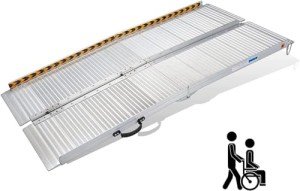Wheelchair Ramps for Steps: A Comprehensive Guide
Accessibility is a crucial element of contemporary design, as it guarantees that everyone, regardless of physical ability, can access structures and public areas. Wheelchair ramps are essential functions that facilitate this access, especially in environments where steps are present. This blog post will check out the different types of ramps, their advantages, elements to consider when selecting a ramp, and frequently asked questions to help you make notified choices.
Understanding Wheelchair Ramps
A wheelchair ramp is a likely surface developed to connect different levels, enabling people who use wheelchairs, walkers, or other mobility aids to navigate steps safely. They are especially essential in commercial and residential settings, where barriers such as stairs can hamper access.

Kinds of Ramps
There are numerous types of wheelchair ramps available, each matched to various needs and environments:
| Type of Ramp | Description | Ideal Use Case |
|---|---|---|
| Portable Ramps | Lightweight and easy to transfer | Temporary access or outdoor events |
| Threshold Ramps | Brief ramps created for door thresholds | Homes with small steps or raised entrances |
| Modular Ramps | Prefabricated ramps that can be set up | Long-term solutions for buildings with several levels |
| Solid Ramps | Tough permanent setups | Public structures and business areas |
| Automobile Ramps | Created for loading and dumping lorries | Carrying mobility equipment or individual usage |
Benefits of Wheelchair Ramps
Increased Accessibility: Wheelchair ramps provide vital access for those with mobility challenges, guaranteeing they can get in and leave structures independently.
Security: By offering a safe alternative to steps, ramps assist avoid accidents that can occur when navigating stairs.
Improved Independence: With a wheelchair ramp, users can browse places without help, considerably boosting their sense of autonomy.
Regulative Compliance: Many locations have laws requiring public structures to be accessible. Installing ramps can assist companies meet these legal requirements.
Increased Property Value: Accessibility functions like ramps can make residential or commercial properties more enticing to prospective purchasers or occupants.
Key Considerations When Choosing a Wheelchair Ramp
Choosing the best wheelchair ramp requires cautious factor to consider of numerous elements:
Length and Incline: The length of the ramp is crucial. An advised incline is 1:12 (for every inch of height, there must be at least 12 inches of ramp run). This guarantees that the ramp is not too steep.
Width: The ramp should be wide sufficient to accommodate the wheelchair comfortably. The minimum width is normally 36 inches.
Product: Ramps been available in various products, including aluminum, wood, and rubber. Aluminum is long lasting and weather-resistant, making it ideal for outside use.
Weight Capacity: Ensure the ramp can support the weight of the wheelchair and the user. The majority of ramps have actually a specified weight limitation; selecting one that surpasses expected loads is finest.
Location: The placement of the ramp is important for usability. It needs to lie where it supplies the most access and security.
Relieve of Installation: Some ramps are portable and need no installation, while others might require professional installation. Consider how frequently the ramp will be used and who will use it.
Ramp Installation
Setup of wheelchair ramps can vary based on the kind of ramp selected. Portable ramps typically require little to no installation, while modular and strong ramps may need professional setup.
Installation Steps for Modular Ramps:
Measure the Access Point: Determine the height of the steps to determine the ramp length required.
Protect Permissions: Ensure you have any needed authorizations or authorizations from your regional authorities.
Set up the Base: Attach the base of the ramp safely to the ground or steps.
Assemble the Framework: Put together the modular sections according to the manufacturer's directions.
Check for Stability: Ensure the ramp is stable and safely attached before use.
FAQ About Wheelchair Ramps
Q1: Do I need a permit to install a wheelchair ramp?
A: Many municipalities need permits for setting up wheelchair ramps, specifically long-term structures. It's important to check regional policies and obtain the essential approvals before setup.
Q2: How do I maintain my wheelchair ramp?
A: Maintenance will depend upon the material. Regularly inspect for any damage, clean the surface area to avoid slipperiness, and make sure that any bolts or anchors remain protected.
Q3: How can I ensure the ramp is safe for all users?
A: To optimize safety, guarantee the ramp has a non-slip surface, proper hand rails, sufficient lighting, and meets regional building codes for slope and width.
Q4: Are there grants readily available for wheelchair ramp building and construction?
A: mymobilityscooters Various federal government and nonprofit organizations offer monetary support for availability remodellings, including wheelchair ramps. Research study programs in your area or seek advice from a local disability advocacy group for info.
Q5: Can I utilize a wheelchair ramp with other mobility gadgets?
A: Yes! A lot of wheelchair ramps are created to accommodate various mobility aids, consisting of walkers, scooters, and strollers.
Wheelchair ramps play an essential role in ensuring accessibility for people with mobility obstacles. When picking and installing a ramp, various elements should be considered to ensure safety, performance, and compliance with policies. By providing accessible entrances, businesses and property owners contribute to a more inclusive neighborhood. With the best information and planning, navigating steps can become a smooth experience for everybody.

